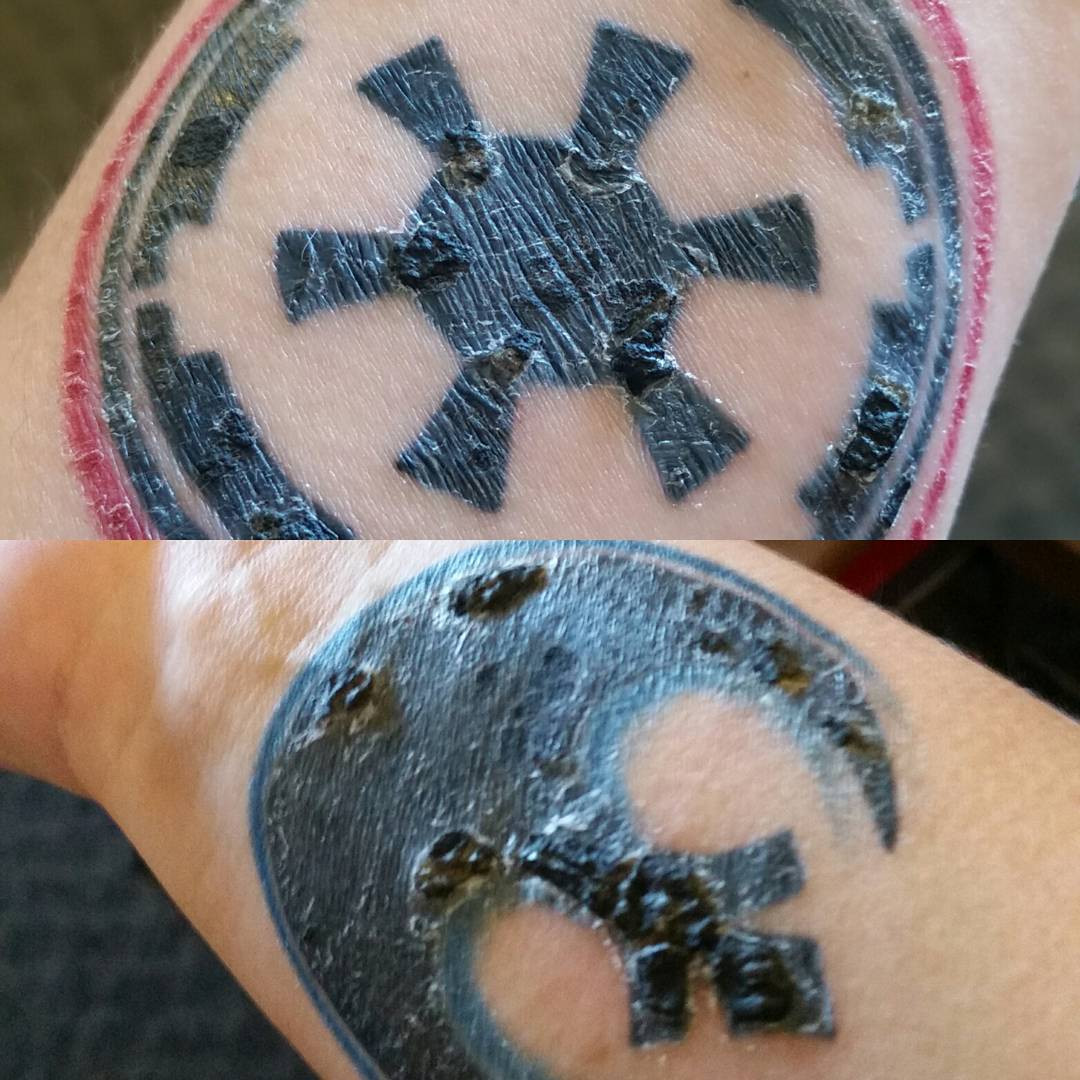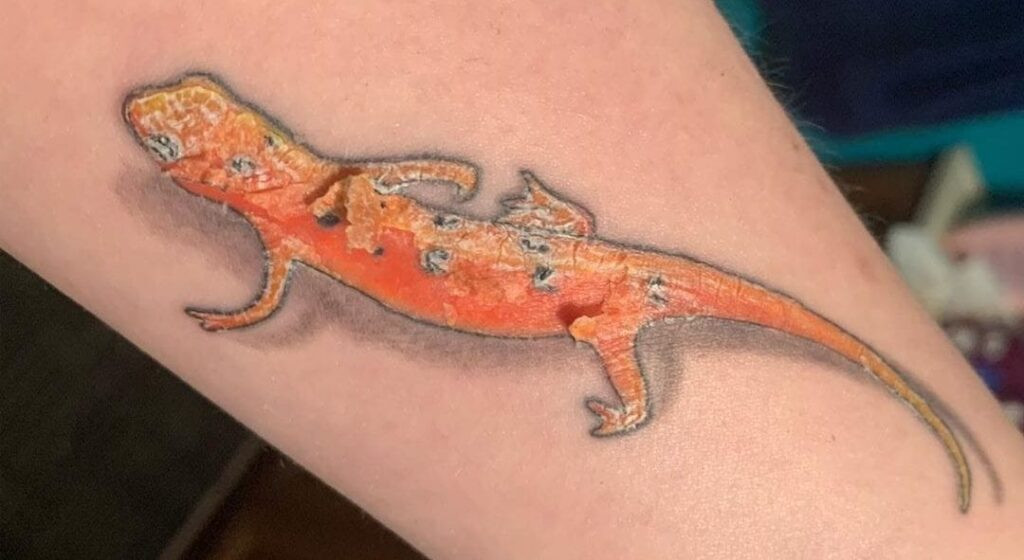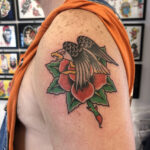Getting a new tattoo is an exciting experience, but the healing phase can sometimes bring about concerns. One common phenomenon that new tattoo enthusiasts encounter is peeling. Witnessing flakes of colored skin shedding from your fresh ink can be alarming. You might wonder if your tattoo is losing color, if the ink is coming off, or if something is going wrong. Rest assured, tattoo peeling is a completely normal part of the healing process. However, understanding why it happens, how long it lasts, and how to manage it can significantly improve your healing experience and the longevity of your tattoo.
This article will delve deep into the world of tattoo healing, focusing specifically on the peeling phase. We will explore the science behind it, discuss the typical timeline, provide essential do’s and don’ts, and offer expert advice on how to care for your tattoo during this crucial stage. Our goal is to empower you with the knowledge to navigate tattoo peeling with confidence and ensure your artwork heals beautifully.
What’s the Deal with Tattoo Scabbing?
To understand peeling, it’s helpful to first touch upon scabbing, another related aspect of tattoo healing. When you get a tattoo, thousands of tiny needle punctures create a controlled wound on your skin. Your body’s natural defense mechanism kicks in immediately, initiating the healing process. One of the first steps is often the formation of scabs.
Think of scabbing as your skin’s emergency bandage. It’s a protective layer that forms over the tattooed area to shield the wound from bacteria and other external contaminants. Unlike a deep, bloody scrape scab, tattoo scabbing is usually more subtle. The tattooed skin may become slightly hardened as plasma and blood dry on the surface, creating a thin, protective layer. This layer is essential for initial protection, but it’s also something we ideally want to minimize.
 Minor tattoo scabbing example
Minor tattoo scabbing example
Minor tattoo scabbing is a step beyond normal peeling and something you ideally want to avoid through proper aftercare.
Beneath the scab, your skin is working hard to regenerate. New skin cells are forming, and the damaged layers are being repaired. However, when a thick scab peels off, it can unfortunately pull away more than just dead skin. It can also remove layers of skin containing tattoo ink, potentially leading to ink loss, unevenness, and a faded appearance in your tattoo. This is why preventing heavy scabbing and managing peeling effectively are key to optimal tattoo healing and vibrant, long-lasting ink.
Is Tattoo Peeling Really Normal?
Absolutely! Tattoo peeling is not just normal; it’s a sign that your skin is healing as it should. Think of it as your skin naturally shedding the damaged outer layers to reveal the fresh, new skin underneath. This exfoliation process is a vital part of how your body repairs itself after the tattooing process.
Within a few days of getting inked, you’ll likely notice the start of peeling. This is a positive indicator that your skin is regenerating and pushing out the damaged, superficial cells. It’s a natural turnover process, making way for healthy, new skin to surface.
However, it’s important to differentiate normal peeling from excessive peeling or other concerning symptoms. While some peeling is expected, be mindful of signs like excessive redness, swelling, prolonged inflammation, unusual discharge, or intense pain. These could indicate potential issues like infection, and it’s always best to consult with your tattoo artist or a healthcare professional if you have any concerns.
Tattoo Peeling: The Skin’s Exfoliation Process Explained
 Typical tattoo peeling/flaking example
Typical tattoo peeling/flaking example
Typical tattoo peeling and flaking is a normal part of healing, but minimizing it is still beneficial for tattoo vibrancy.
To understand tattoo peeling, think about your skin’s natural exfoliation process. Every day, your skin sheds millions of dead skin cells in a process called exfoliation. Usually, this is unnoticeable, happening on a microscopic level. However, a tattoo essentially accelerates this process in the tattooed area.
The tattooing needles create micro-injuries to the epidermis, the outermost layer of your skin. In response to this controlled trauma, your body initiates a more intense exfoliation in that specific location. The epidermis starts to shed the damaged cells in larger, more visible flakes – this is tattoo peeling.
The flakes you see during tattoo peeling will contain pigment because the ink is deposited into the dermis, the layer of skin beneath the epidermis. While some superficial ink might be present in the peeling skin, the majority of the tattoo ink resides safely within the deeper dermal layer. Therefore, normal peeling should not significantly impact the vibrancy or detail of your tattoo.
While peeling is a natural and necessary part of healing, minimizing excessive peeling is still beneficial. Less peeling generally means a lower chance of scabbing, reduced itchiness, and a smoother healing process overall.
Tattoo Peeling Timeline: When Does it Start and How Long Does it Last?
The question “How Long Does A Tattoo Peel?” is a common one. Typically, tattoo peeling begins around day four or five after getting inked. However, this is just an average, and the exact timing can vary from person to person. Some individuals may start peeling as early as day two or three, while others might not notice it until about a week later.
Once peeling starts, it generally lasts for about one to two weeks. The duration and intensity of peeling can be influenced by several factors:
- Individual Skin Type and Healing Rate: Just like healing from any wound, the speed of tattoo healing and peeling varies based on individual skin type, genetics, and overall health.
- Tattoo Location: Areas of the body that experience more friction or movement, such as fingers, elbows, or areas under clothing that rubs, might peel for a longer duration. Skin in these areas naturally exfoliates less frequently.
- Tattoo Size and Ink Saturation: Larger tattoos or those with heavy ink saturation may experience more noticeable peeling simply because there is a larger surface area healing.
- Tattoo Technique and Artist’s Style: The depth and technique used by the tattoo artist can also play a role. Tattoos done with a lighter touch might result in less initial trauma and potentially less peeling.
- Aftercare Practices: This is a significant factor. Proper aftercare, including moisturizing and keeping the tattoo clean, can influence both the onset and duration of peeling. Using a wet healing method with a breathable bandage like Saniderm can also significantly impact peeling.
Normal tattoo peeling can range from a few days to up to a month in some cases, although a month is on the longer end. If you are concerned about prolonged or excessive peeling, consulting with your tattoo artist is always a good idea.
The Benefits of Wet Tattoo Healing for Minimizing Peeling
The “wet healing” method, often utilizing a dermal tattoo bandage like Saniderm, has gained popularity for its effectiveness in promoting optimal tattoo healing and reducing peeling. This method contrasts with traditional “dry healing,” which involves leaving the tattoo exposed to air after the initial bandaging.
Wet healing offers several advantages when it comes to minimizing tattoo peeling:
- Moisture Retention: Dermal bandages create a breathable yet sealed environment that locks in your body’s natural healing fluids. This moisture-rich environment prevents the tattoo from drying out excessively, which is a major contributor to scabbing and subsequent peeling.
- Protection from Contaminants: Bandages like Saniderm act as a barrier against external contaminants like bacteria, dirt, and friction from clothing. This protection minimizes the risk of infection and irritation, allowing the skin to heal more smoothly and with less trauma.
- Reduced Scabbing: By maintaining a moist environment and preventing the tattoo from drying out and forming thick scabs, wet healing significantly reduces scabbing. Less scabbing directly translates to less peeling, as the skin heals more efficiently without forming thick layers of dead skin to shed.
- Enhanced Ink Retention: By minimizing scabbing and promoting a smoother healing process, wet healing can contribute to better ink retention. There’s less chance of ink being pulled away with thick scabs during peeling.
Saniderm bandages promote wet healing by protecting the tattoo and locking in moisture.
It’s crucial to understand that dermal bandages like Saniderm are different from simple plastic wrap (cling film). Saniderm is specifically designed for tattoo healing. It’s breathable, allowing oxygen and water vapor exchange, which is essential for proper wound healing, while still being waterproof and bacteria-proof. This breathability is a key advantage over non-breathable wraps like cling film, which can trap moisture and potentially create an environment conducive to bacterial growth if left on for extended periods.
Read More: How Does Saniderm Work?
DO’s for Caring for a Peeling Tattoo
Proper care during the peeling phase is crucial for ensuring your tattoo heals beautifully and retains its vibrancy. Here are essential “DO” actions:
- DO Wear Loose Clothing: Tight clothing can rub against your peeling tattoo, causing irritation and potentially pulling off flakes prematurely. Opt for loose, breathable clothing to minimize friction and allow your tattoo to breathe.
- DO Allow Natural Healing Time: Patience is key. Let your body heal at its own pace. Avoid rushing the process or picking at the peeling skin. Remember that a few weeks of healing are a short time compared to a lifetime with your tattoo.
- DO Keep the Tattoo Clean: Gently cleanse your tattoo once or twice a day with a mild, fragrance-free antibacterial soap. This removes bacteria and debris, promoting a clean healing environment. If using wet healing with bandages, clean the tattoo before applying a fresh bandage as instructed by the bandage manufacturer or your artist.
- DO Moisturize Regularly: Keeping your tattoo moisturized is vital during peeling. Use a tattoo-specific moisturizer or a fragrance-free, hypoallergenic lotion. Apply a thin layer after cleaning and whenever your tattoo feels dry or itchy. Moisturizing helps soothe itchiness, keeps the skin hydrated, and can minimize excessive peeling.
DO NOT’s for Caring for a Peeling Tattoo
Just as important as the “DOs” are the “DO NOTs.” Avoid these actions to prevent complications and ensure optimal healing:
- DO NOT Pick or Pull at Peeling Skin: This is perhaps the most crucial “DO NOT.” Picking at flakes, even if they seem to be hanging by a thread, can be incredibly damaging. You risk pulling off healthy skin along with the peeling flakes, leading to open wounds, ink loss, scarring, and potential infection. Let the skin shed naturally.
- DO NOT Scratch or Rub the Tattoo: It’s normal for a peeling tattoo to itch. However, resist the urge to scratch or rub it vigorously. Scratching can introduce bacteria from under your fingernails, increasing infection risk. It can also damage the healing skin and distort the tattoo. Gently pat or lightly slap the area to relieve itching if needed, or apply moisturizer.
- DO NOT Over-Moisturize: While moisturizing is essential, applying too much moisturizer can also be detrimental. Over-moisturizing can trap moisture and create an environment that’s too damp, potentially hindering healing and increasing the risk of bacterial growth. Apply a thin layer of moisturizer, just enough to keep the skin hydrated, and allow it to absorb.
- DO NOT Soak the Tattoo: Avoid prolonged soaking in water, such as baths, swimming pools, hot tubs, or even long showers, especially in the initial peeling phase. Excessive water exposure can soften scabs (if any) and peeling skin, making them more likely to come off prematurely and potentially leach ink. Quick showers are fine, but avoid directly submerging the tattooed area for extended periods.
Recognizing Signs of Improper Tattoo Healing
While peeling is normal, it’s important to be vigilant and recognize signs that might indicate a problem beyond typical healing. Be aware of these potential warning signs:
- Systemic Symptoms: Flu-like symptoms such as fever, chills, or body aches are red flags. These suggest your body is fighting a larger infection and require immediate medical attention.
- Excessive Redness and Swelling: Some redness and mild swelling are normal initially. However, if redness intensifies, spreads beyond the tattoo area, or if swelling becomes pronounced and doesn’t subside after a few days, it could indicate infection or inflammation.
- Unusual Discharge: A small amount of clear fluid or blood in the first 24-48 hours is normal. However, if you notice persistent oozing, especially if the discharge is thick, cloudy, yellowish, greenish, or has a foul odor, it’s a strong sign of infection.
- Excessive Pain and Heat: While some tenderness is expected, increasing pain that is disproportionate to the initial tattooing process, or if the tattoo feels excessively hot to the touch, could indicate infection.
- Itchy Bumps or Hives: While some itchiness is normal during peeling, the sudden appearance of raised, itchy bumps, hives, or a rash around the tattoo area could suggest an allergic reaction to the ink or aftercare products.
- Scarring: While minor scarring is sometimes unavoidable, significant raised scarring, keloid formation, or pitted scars are not normal outcomes of proper tattoo healing and should be addressed.
If you experience any of these signs, it’s crucial to consult with your tattoo artist or seek medical advice from a doctor or dermatologist promptly. Early intervention can prevent complications and ensure your tattoo heals properly.
What to Apply to a Peeling Tattoo for Optimal Healing
Choosing the right products and practices is essential to support your peeling tattoo and promote healthy healing:
- Gentle Cleansing: Use a mild, fragrance-free, antibacterial soap specifically designed for sensitive skin or tattoo aftercare. Harsh soaps can irritate the healing skin.
- Tattoo-Specific Moisturizers: Opt for moisturizers formulated for tattoo aftercare. These are typically water-based, fragrance-free, and contain ingredients that promote healing and soothe the skin. Sanibalm is an excellent example of a tattoo-specific balm.
- Sun Protection: Once your tattoo is fully healed, sun protection becomes paramount for preserving its vibrancy. UV radiation can fade tattoo ink over time. Apply a broad-spectrum sunscreen with SPF 30 or higher to your healed tattoo whenever it’s exposed to the sun.
- Avoid Tanning Beds: Tanning beds emit concentrated UV radiation, which is even more damaging to tattoos than natural sunlight. Avoid tanning beds to protect your skin and your tattoo ink.
- Consult a Dermatologist: If you have persistent skin reactions, concerns about scarring, or any unusual changes in your tattoo, don’t hesitate to seek professional advice from a dermatologist. They can provide expert guidance and treatment for any skin-related issues.
Tattoo peeling is a natural and temporary phase in the tattoo healing journey. By understanding the process, following proper aftercare guidelines, and using quality tattoo aftercare products, you can navigate this stage with confidence and ensure your tattoo heals beautifully, remaining a vibrant piece of art for years to come. Embracing the peeling process as a sign of healing, rather than a cause for alarm, will make your tattoo experience much smoother and more enjoyable. Remember to always prioritize aftercare and listen to your body throughout the healing process.
